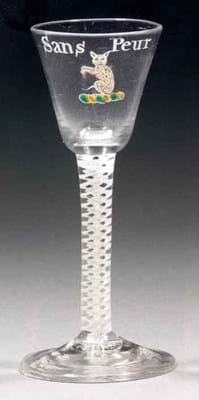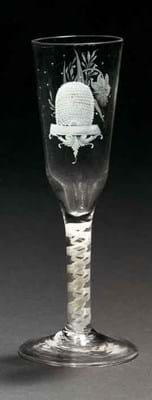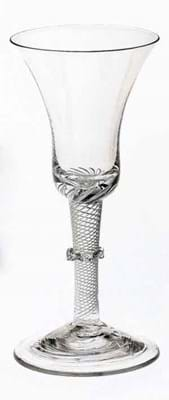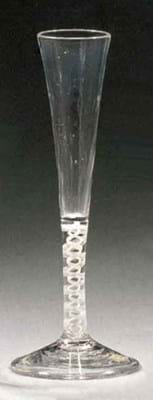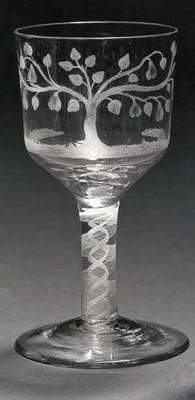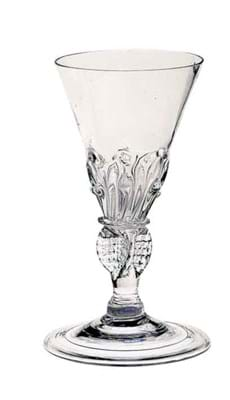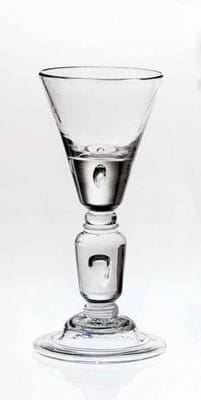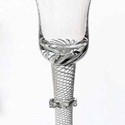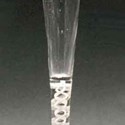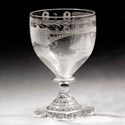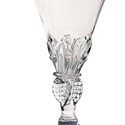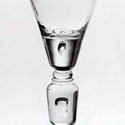This was a slot traditionally filled by Sotheby's, but when they stopped holding dedicated glass sales and their specialist Simon Cottle moved to Bonhams, the specialist glass sales travelled with him.
Last summer saw Cottle's first dedicated glass sales: around 420 lots comprising the single-owner Thomas Collection and a mixed-owner event on June 4. Last month, glass was once again filling the traditional December slot as, aided by the success of the June events, Bonhams Bond Street (20/12% buyer's premium) offered another double hander on the 17th.
The morning was devoted to the 208- lot James Hall collection of English glass, followed by 321 lots of British and European mixed ownership. When one compares their 529-lot December tally with the 43 lots of English and Continental glass in Christie's November 18 ceramics auction, and just a couple of pieces at Sotheby's on December 2, it is clear that Bonhams are firmly on the map as the main London location for antique drinking glasses.
James Hall, who died in 2005, had been collecting glass seriously since 1971, but was particularly active from 2002 after his retirement. Buying from well regarded dealers like Delomosne and Jeanette Hayhurst and from the major salerooms, he concentrated on classic English glassmaking, but built up a collection that took in most representative and specialist forms, with a focus on the late 17th and early 18th century period.
For the afternoon, Mr Cottle had combined several smaller collections: 18th century drinking glasses from Frank Ffoulkes' and the Hunter collection consigned from the Channel Islands, plus paperweights from the estate of Philo Woodrow Van Wagoner, with a swathe of mixed-owner material.
Taken all together, this offered a wealth of classic 18th century English drinking glasses covering all the standard conformations plus the specialist sub-sections in which wellheeled collectors like to specialise. There was also a smaller selection of the less buoyant Continental material. Rich pickings indeed.
Sales Volume
One can argue that these days a saleroom needs to make something of a splash in providing the critical mass to attract the buyers. But as discussed in last week's London Selection where I reported on the glut of Worcester porcelain offered in the same rooms this year, there is a downside to such a feast.
Give buyers too much choice and they can become choosy. So while these sales turned in respectable totals, there was some fallout from the sheer volume on offer. Take-up by lot was around 73 per cent for the Hall sale and down to around 57 per cent for the mixed-owner offering (although aftersales improved that with the Hall sale up to over 80 per cent by early January).
In any sector of the art market, from Old Masters to tinplate toys, buying is about assessing the opportunity. If it's a scarce or one-off occasion, there will be no shortage of takers, but move down the scale to rare but obtainable, and on to good but widely available and it's all about pricing levels.
So while the marketing and large attendance gathered for these sales benefited the scarcer pieces, it was harder going for the middle-of-the-road material. New buyers from the US - private and institutional - bidders from South Africa, Australia and even Continental Europe all swelled the home interest, scrabbling to secure trophy pieces and boosting the prices for Beilbys, Jacobites, big-statement balusters and colour twists. But it's a different story for middle of the road drinking glasses.
This is an area where auctioneers often rely on the trade to buy for stock, but these days dealers will only do this if it is very cheap. In the December sales anything pitched aggressively or with damage found it much harder, especially when faced with a glut in some oversubscribed fields.
New Buyers
Simon Cottle felt that estimates set six months ago when post-June results augured more buoyancy did not help. And he also defended the inclusion of middle-of-the-road material in volume as necessary to attract a cross section of collectors. "To keep a market alive, you need to bring in the new buyers," he said.
There are signs the policy was working: some first-time customers who bought when Bonhams offered cheaper material from the Thomas collection in their Knowle rooms turned up at Bond Street in December. And even at the lower end of the scale it is not all doom and gloom. There were those aftersales. It was also interesting to note that glasses from the James Hall collection, some of which had been acquired recently and at bullish prices, still managed to clear at least a nominal profit for more standard elements as well as rarities.
One can tell this because his well provenanced catalogue gave plenty of information about where many of his glasses were sourced, giving the opportunity to compare last month's prices with what he had paid at auction.
So alongside the engraved blue colour twist ale glass that cost him £2800 in Bonhams six years ago and made £5800 last month was a large airtwist stemmed goblet that fetched £900 last month compared to £500 in 2004 and a standard mid-18th century trumpet bowled, hops and barley engraved ale on a double knopped multi-spiral airtwist stem, that improved on a £680 price at Bonhams in 2002 to take £750 this time. The overall hammer take of around £720,000 on top of around £600,000 from June is not to be sneezed at either.
Some of that may be produced by five-figure sums from collectors ensuring they can add a Jacobite or baluster goblet to their collections, but more modestly priced drinking glasses contributed to much of the volume. We illustrate a selection from both ends of the scale. Overall, it suggests that English glass is a market with enough breadth and depth to be better placed than many to weather 2009's potentially choppy trading conditions.
Enamelled Glass
The 1760s enamelled glasses attributed to the Beilby family in Newcastle always pack a punch. Last month at Bonhams collectors were particularly well served with eight examples ranging from those with simple white floral bands to more elaborate architectural scenes, peacocks, beehives and polychrome armorials. The only element lacking was the grandest of all the Beilby incarnations - the privateer or armorial goblets.
Two Beilbys provided the highest prices in the James Hall sale. A 7.5in (19cm) high opaque twist goblet painted with peacocks fetched £17,000, towards the upper end of the punchy £12,000- 18,000 guide.
Following at £14,000 was this 7.25in (18.5cm) high opaque twist ale elegantly painted with a bee skep to one side and a floral spray to the other. A rare firing glass painted with the arms of the Lodge of Journeymen and Masons of Edinburgh sold for £9500 (it fetched £11,000 at Bonhams Edinburgh rooms in 2004). The mixed-owner sale included this interesting 6in (15cm) high opaque twist enamelled with a cat séjant and the motto Sans Peur - one of a series of glasses that appear to be by a different Newcastle workshop. Its insignia may relate to the Earl of Sutherland's arms.
It sold for £11,000.
English Balusters
Early balusters were another plentiful glass form in these sales. With so many in the Hall collection buyers were selective but prepared to pay handsomely for the best examples. This enthusiasm comes partly from new North American buyers for these muscular glasses.
Some of these are collectors of early bottles who are making a connection between the two forms. Others are institutions who want an example of these early drinking vessels to complement other colonial era artefacts in their holdings.
Size matters but equally important in the world of baluster collecting are proportion and features such as stem shape.
The most surprising result came with a 11.5in (29cm) heavy baluster goblet on a teared stem in the Hall collection that matched its mammoth size with a mammoth price - £10,000 - courtesy of American bidding.
The day's other baluster goblet of the same date and size but with an inverted baluster stem made £7000 in the mixed owner auction.
Smaller at 6in (14cm) but elegantly proportioned, with its teared bowl and cylinder stem divided by a flattened knop and merese, was this c.1715 wine glass that realised £6000.
Jacobite Glass
Jacobite glasses have bounced back from any doubts about authenticity that affected their fortunes a few years ago and are now on a roll.
New collectors, including some Americans, have entered the market which has helped boost interest. There have been signs of this revival in many recent auctions notably the strong prices paid at Bonhams Edinburgh rooms for three fairly standard Jacobite wine glasses that happened to come from the collection of Geoffrey Seddon, author of the influential reference book The Jacobites and Their Glasses.
More recently Tamlyns sold a set of 13 facet stem glasses from the Welsh Jacobite Society for a total of £21,600 (see ATG No 1870, September 20/27).
The Jacobite glasses in Bonhams' December sales were mostly simple 18th century wines with engraved rose and bud motifs but one example in the mixed owner sale stood out by virtue of its size, shape and provenance. This 10in (26cm) high baluster glass is known as The Torpichen Goblet after an early 20th century owner Lord Torpichen.
Last offered for sale at Sotheby's in 1992 where it fetched £3200, here it generated keen competition from the UK and overseas bidders selling for £13,000 to a British collector.
Colour Twists
There are collectors at a certain level who love to add an example of a colour twist wine glass to their holdings making them a strong specialist area. Bonhams offered punters around 20 examples of these 1760-70s glasses, the bulk in the James Hall sale.
Although lacking an example of the most desirable canary yellow threaded stem, there was a good spread of other colours. The most expensive was this James Hall blue twist, a variant on the usual form being a 7.5in (19cm) high ale engraved to the funnel bowl with hops and barley. It fetched £5800, double what it made six years ago in the same rooms.
Cameo Glass
The potential stars of the later 19th century decorative glass that made up a small but notable section of Bonhams' sales were all pieces of cameo glass. As expected, the best seller was the 12in (30cm) high, two-handled vase carved with The Milkmaid by the Victorian master of the genre, George Woodall.
It sold at the lower end of a punchy £30,000-£50,000 estimate.
More unexpected was the keen competition for this 11in (27.5cm) Islamic taste Thomas Webb vase.
Unsigned, but attributed to the Woodall workshop, Bonhams had guided it at £8000-12,000, based on the £12,000 paid at Sotheby's four years ago for a similar version. But stiff competition, including interest from a UK institution, saw it taken to £23,000, selling to an American buyer.
Paperweights
As an American-led market, paperweights have been volatile performers recently, but perhaps the relative strength of the dollar now has added impetus to buyers from across the Pond.
While the overall take-up for 60-odd lots on offer here was around 60 per cent, there were some very strong individual prices. One was the £11,000 paid for a large, 4.5in (11.5cm) diameter Mount Washington weight featuring a large shaded pink and white rose. It was notable, said Simon Cottle, because American weights usually perform strongest on home territory.
Topping the bill, though, was this c.1850 Baccarat faceted Swans-in-a-Pond weight. This design only rarely surfaces at auction. Sotheby's sold a version with two swans but with some condition issues in their New York Historical Society auction in 1995 for $6000. It's a mark of the scarcity and good condition of this example that it fetched £20,000.

